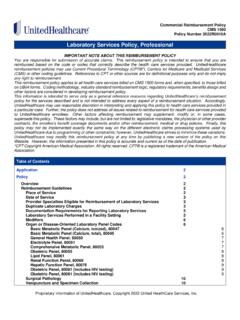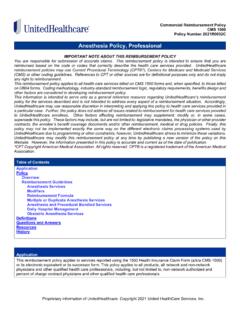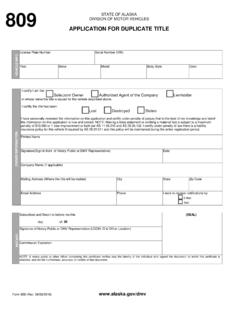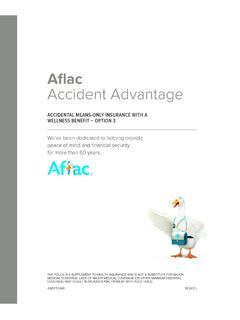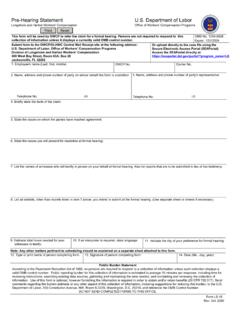Transcription of Periodontal Scaling and Root Planing Policy
1 Periodontal Scaling and Root Planing Policy United Concordia's Policy for claims submission of Periodontal Scaling and root Planing (PSRP). (D4341, D4342) requires submission of diagnostic materials from all general dentists and non . Periodontal specialists, regardless of the patient's age. The required diagnostic materials include: Full mouth duplicate radiographs or digital images Full mouth charting, including 6 points per tooth For PSRP to be considered for a benefit, the diagnostic materials must demonstrate the following, consistent with professional standards: Clinical loss of Periodontal attachment and/or Radiographic evidence of crestal bone loss or changes in crestal lamina dura and/or Radiographic evidence of root surface calculus If these criteria are not evident upon professional review, the claim for PSRP cannot be approved.
2 Bone loss must be evident on the radiographs to justify the presence of calculus and bacterial deposits on root surfaces. Scaling of calculus and bacterial deposits from enamel surfaces, whether supragingival or subgingival does not constitute root Planing . Clinical Clarification of Periodontal Scaling and Root Planing The ADA Current Dental Terminology describes Periodontal Scaling and root Planing as: This procedure involves instrumentation of the crown and root surfaces of the teeth to remove plaque and calculus from these surfaces. It is indicated for patients with Periodontal disease and is therapeutic, not prophylactic, in nature. Root Planing is the definitive procedure designed for the removal of cementum and dentin that is rough, and/or permeated by calculus or contaminated with toxins or microorganisms.
3 Some soft tissue removal occurs. This procedure may be used as a definitive treatment in some stages of Periodontal disease and/or as a part of pre surgical procedures in others. The Journal of Periodontology, May 2000 (Supplement), p. 853, further states, in part, that the conditions necessary for root Planing must be characterized by a loss of clinical attachment due to destruction of the Periodontal ligament and loss of the adjacent bone support.. Additionally, there must be inflammation of the gingiva extending into the adjacent attachment apparatus . Current Dental Terminology 2014 American Dental Association. All rights reserved. Page 1 of 4. The ADA Current Dental Terminology describes a dental prophylaxis as: Removal of plaque, calculus and stains from the tooth structures in the permanent and transitional dentition.
4 It is intended to control local irritational factors. Given these descriptions: PSRP is Periodontal treatment that involves instrumentation of root surfaces and removal of deposits, toxins and microorganisms from root surfaces. If bone loss is not evident and/or deposits involve enamel surfaces only, whether supragingival or subgingival, PSRP is not the appropriate procedure to report, since root surfaces could not have been planed. When the deposits, toxins and microorganisms are removed from enamel surfaces only, the dentist may want to consider whether the service rendered more closely relates to the definition of either a prophylaxis (D1110) or a full mouth debridement (D4355).
5 In cases where a comprehensive oral evaluation cannot be completed without preliminary debridement, D4355 can be reported, which is described as gross removal of plaque and calculus that interfere with the ability of the dentist to perform a comprehensive evaluation. It should be noted that: Pocket depths are not the sole indicators for PSRP, since pockets can exist in the absence of bone loss due to inflammation of the gingival tissues ( , pseudo pockets). A patient with pocket depths of 4, 5 or even 6 mm can have calculus on enamel surfaces only, with no bone loss. Removing this calculus from enamel surfaces, even subgingivally does not constitute PSRP, no matter how difficult or time consuming the removal may be.
6 A prophylaxis is the appropriate code to report when removing calculus (supragingivally and/or subgingivally) from the teeth, even when the calculus extends below the gum line and there is no bone loss. It is vitally important that patients be encouraged to take an active role in the maintenance of their oral health and the prevention of dental disease. A patient who is non compliant with home care instructions may require more than the contracted limit of prophylaxis allowed per year. Patients who require additional prophylaxis are responsible for the fees associated with all services that exceed the limits of the dental benefit program. Please read on for examples of a case that would be approved, as well as a case that would be denied.
7 Current Dental Terminology 2014 American Dental Association. All rights reserved. Page 2 of 4. The following is an example of a case that would be approved. The radiograph clearly demonstrates bone loss. Typically the bone level is at or close to the part of the tooth where the crown and root meet. There is also radiographic evidence of calculus (small nodules evident on root surfaces between the teeth) in all areas of the mouth. This patient has periodontitis, which is a disease that results in bone loss leaving root surfaces of teeth exposed to the oral environment. This allows saliva, food particles, and bacteria to attach to root surfaces. When that occurs, it is necessary to remove these irritants from the root surfaces, thus the term root Planing .
8 Scaling in this case is provided on the crown surfaces of teeth. Current Dental Terminology 2014 American Dental Association. All rights reserved. Page 3 of 4. The following is an example of a case that would be denied. The radiograph demonstrates no clear bone loss. The bone level is at or very close to the junction of the crown and root. There is evidence of calculus (those small nodules noted between the teeth) but those nodules are on the crown of the tooth, not the root. The root surfaces of the teeth are NOT exposed to the oral environment and are safe from saliva, food particles, and bacteria. As a result, the roots cannot be planed. However, the crowns of the teeth ARE exposed and subject to collecting these irritants commonly called by patients as tartar (the scientific term is calculus).
9 Calculus on crown surfaces does irritate the gum (gingival) tissue causing the tissue to swell, turn red, and bleed. This calculus must be removed from crown surfaces by Scaling and is part of a routine prophy, even when removing calculus from below the gum line since part of the crown of the tooth is below the gum line. Current Dental Terminology 2014 American Dental Association. All rights reserved. Page 4 of 4.


